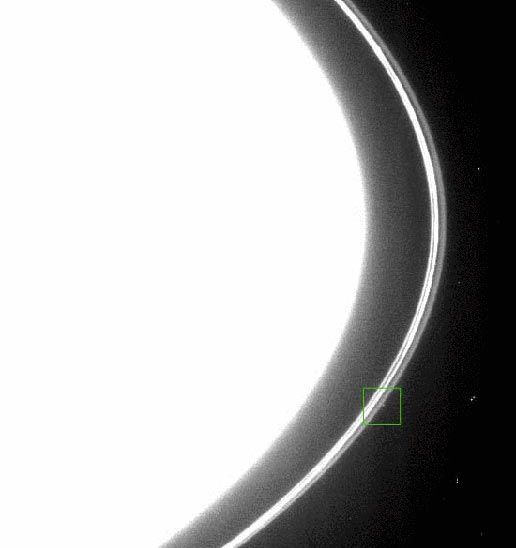New Ring and Possible Moons Found at Saturn

The Cassini spacecraft has detected two and possibly three new additions to the already full environment of Saturn, and scientists are puzzled over what they've seen.
The first discovery is a wispy arc of ice and rocky material that sits between the A and F rings. The second is a tiny object skirting the outer edge of the F ring, which may be a moon but could just be a clump of rubble, scientists said this week. A third object is even more enigmatic.
At a distance of 86,000 miles (138,000 kilometers) from the center of Saturn, the previously unknown ring, designated S/2004 1R, lies in the orbit of the small moon Atlas. It is unknown yet whether the ring actually makes a full circle around the planet or is just an arc.
Astronomers have estimated the width of material in the ring to be 190 miles (300 kilometers). In comparison, the A ring is 9,070 miles (14,600 kilometers) wide, while the F ring is 31 miles (50 kilometers) wide.
The ring system begins from the inside out in this order: D, C, B, A, F, G, E.
The other discovery is an object, temporarily called S/2004 S3, which is estimated to be 2 to 3 miles (4 to 5 kilometers) across. It orbits Saturn at a distance of approximately 86,420 miles (141,000 kilometers) from the center of the planet, which places it about 600 miles (1,000 kilometers) outside of the F ring.
The resolution is not yet good enough to determine the exact nature of the newfound object. If it turns out to be a solid body, it would be the 34th satellite around Saturn. Earlier this summer, NASA announced the discovery of two Saturn moons, S/2004 S1 and S/2004 S2, which are of similar size to S/2004 S3.
Breaking space news, the latest updates on rocket launches, skywatching events and more!
Carl Murray, Cassini imaging team member from Queen Mary College, University of London, was the first to notice the new astronomical entities. The possible moon showed up in a series of images taken on June 21, while the ring was spotted in a wide-angle shot from July 1. During this time period, the spacecraft was in the midst of establishing orbit around Saturn.
Another object -- possibly another moon -- was also detected.
When Joseph Spitale, a planetary scientist at the Space Science Institute in Boulder, Colo., looked over the images involvoing S/2004 S3, "I found that about five hours after first being sighted, it seemed to be orbiting interior to the F ring," he said. "If this is the same object then it has an orbit that crosses the F ring, which makes it a strange object."
The dynamics of an object crossing the ring are puzzling, scientists say. For now, the inner object sighted by Spitale is considered a separate object with the temporary designation S/2004 S 4. S4 is roughly the same size as S3.

Michael Schirber is a freelance writer based in Lyons, France who began writing for Space.com and Live Science in 2004 . He's covered a wide range of topics for Space.com and Live Science, from the origin of life to the physics of NASCAR driving. He also authored a long series of articles about environmental technology. Michael earned a Ph.D. in astrophysics from Ohio State University while studying quasars and the ultraviolet background. Over the years, Michael has also written for Science, Physics World, and New Scientist, most recently as a corresponding editor for Physics.
